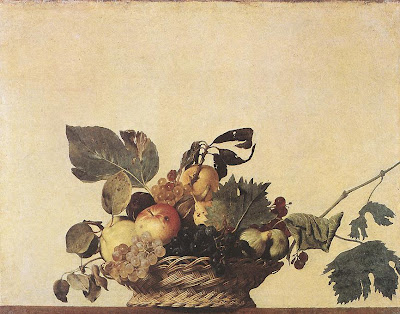Two blogs of
note pushed me into this frame of mind today — Jennifer’s recent post over at Brains on Fire and Valeria’s always good insights at Conversation Agent. Jennifer discussed the recent Wimbledon finals from a non-player’s perspective. Valeria just happens to love Caravaggio. For the rest of us, please pick up your pencils and write down the following:What do you see in this picture above? Thoughts, feelings, impressions, obervations, everything. You fall into one of two camps, if you’re like most people.
The first group will say, in so many words, “this looks like my grandmother’s curtains.” The second group will say, again in so many words, “this is a masterpiece.” What’s the difference between them? It isn’t taste, or education, or a proclivity to ask the next driver for your
Grey Poupon. It’s knowledge, and an appreciation for it.I came across Peter Robb’s excellent
detective story, “M: the Man Who Would Become Caravaggio,” telling the life of the artist Michelangelo Merisi. In it, he not only tells the somewhat sordid and unexpectedly violent life of a Renaissance artist, brawler and habitual drunkard, but dissects each surviving work still existing.The picture, above, is the “Basket of Fruit,” not surprisingly. It is the first still life acknowledged to be painted “from life.” Nor is it a happy picture. The fruit is in varying states of ripeness, some showing obvious signs of rot. It is shown against a blank wall, not in the context of a landscape or other complex background. The shelf upon which it sits appears to be jutting out in an almost three dimensional manner towards the viewer. For an artist in 1597, these are all revolutionary acts.
To me, it’s a masterpiece. It’s been my computer’s wallpaper, off and on, for years. Something about the juxtaposition of a Renaissance still life on a laptop display always gets a comment from someone in the room. But to me, it’s a
masterpiece because I’ve learned more about it than the average casual observer, in a way that was engaging and personal to me. I’m not an art historian by any means, but I can wax poetic on this particular piece.I’ve become an expert in a narrowly defined field, and because of it, I care more deeply about it.
* * *
Key Takeaways:
> We care more deeply about things we learn about. We love things we learn to do well. We teach what we know to others who also enjoy learning. We can’t help it, we’re gregarious, social people and we like to share.
> If we teach people about the inner game of our products and services in a way that is engaging and personal, we have the very real opportunity to become masterpieces in their eyes. This isn’t an entitlement — we still need to produce works of excellence, and still need to appeal to our audiences in ways that are as engaging and personal as possible. But we have a better than average chance.
> Engaging means relevant, expert, helpful, and (importantly) entertaining. Entertaining doesn’t mean slapstick. It means the participant has fun engaging with your brand.
> Personal means directed in a shared and trusted environment to one person who feels that attention is being paid to them and their particular pace, needs and level of understanding.
* * *
In
the language of influence, we’re employing reciprocity — giving the gift of knowledge for which a social contract is subtly being built, in order to create a legion of exclusivity, sharing knowledge that is not commonly available to all.What does this mean to us in our marketing roles? How do you create experts?
Regards.

